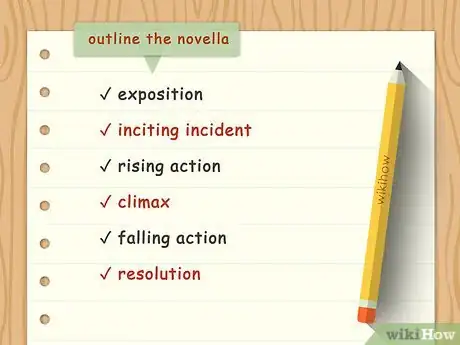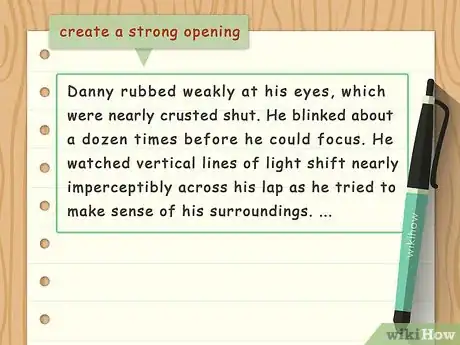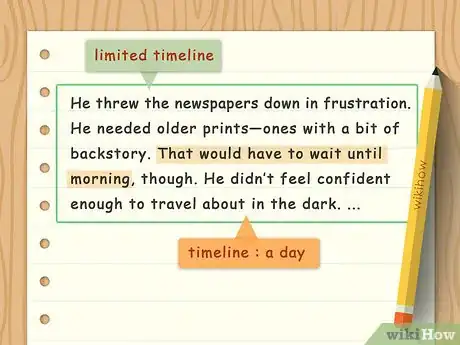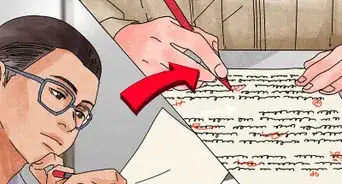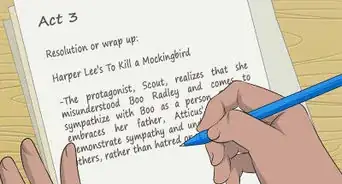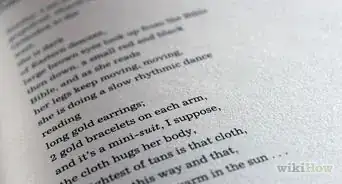This article was co-authored by Stephanie Wong Ken, MFA. Stephanie Wong Ken is a writer based in Canada. Stephanie's writing has appeared in Joyland, Catapult, Pithead Chapel, Cosmonaut's Avenue, and other publications. She holds an MFA in Fiction and Creative Writing from Portland State University.
This article has been viewed 179,781 times.
A novella is a work of fiction that is around 20,000-40,000 words long.[1] Writing a novella is a fun challenge if you are struggling to make the leap from short stories to a novel. A good novella will have the pace and action of a short story, as well as the detailed characters and plot of a novel. Start by brainstorming ideas for the novella. Then, create a first draft and polish it so it is at its best.
Steps
Brainstorming Ideas
-
1Focus on a particular theme or idea. Novellas work best if they are centered on one theme or idea. Choose a theme like “love,” “identity,” or “loss” and explore it in more detail in the novella. Find a theme or idea that you feel you have a lot to write about and use it as inspiration.
- For example, you may write a novella about loss by having a main character who deals with loss in their life.
-
2Create an engaging main character. A good novella will have one main character who acts as a guide for the reader. The main character should be feel like a specific person to the reader, someone they get to know on a personal, intimate level.[2]
- Many novellas are written in the first person, from the perspective of the main character. You can also try using the third person, with the main focus of the novella on the main character.
Advertisement -
3Choose an inspiring setting. Pick a setting that you know well or have a lot to write about. Use the setting as inspiration for the novella.[3]
- For example, you may choose a WWII army base as the setting for the novella. Or you may choose your hometown as the setting.
-
4Read examples of a novella. To get a better sense of the genre, read examples of the novella that are considered successful. You may read:
- The Metamorphosis by Franz Kafka
- Beside the Sea by Veronique Olmi
- No One Writes to the Colonel by Gabriel Garcia Marquez
- The Lifecycle of Software Objects by Ted Chiang
Creating a First Draft
-
1Outline the novella. You can outline for the novel by using a plot diagram, which consists of five sections: exposition, inciting incident, rising action, climax, falling action, and resolution. You can also use a three act structure, where there is a set up, a conflict, and a resolution.[4]
- Another way you can outline the novella is by using the snowflake method. This method consists of four sections: a one sentence summary, a one paragraph summary, a synopsis of characters, and a spreadsheet of scenes.
-
2Create a strong opening. Surprise your reader in the first few lines of your novella. Engage them with a startling image or interesting language. Try to sum up the main conflict or issue of the novella in the first few lines so the reader is aware of the set up.[5]
- For example, Kafka’s novella The Metamorphosis opens with the line: “When Gregor Samsa woke up one morning from unsettling dreams, he found himself changed in his bed into a monstrous vermin.”
-
3Focus on a central conflict. Do not clutter the novella with multiple conflicts or issues. Focus on just one conflict and explore it in detail. The conflict should put pressure on the main character and force them to make a big decision or choice.[6]
- For example, in Kafka’s The Metamorphosis, the main character, Gregor Samsa, is in a conflict where he has to deal with daily existence as a bug, when he does not want to be a bug and would prefer to be human.
-
4Keep subplots and minor characters to a minimum. Having too many subplots and minor characters can cause you to lose focus when you are writing a novella. They can also make the novella too long and wordy. Try to stick to a maximum of one subplot and one to two minor characters in the novella.[7]
- For example, in the novella Beside the Sea by Veronique Olmi, there are only three characters total in the story, a mother and her two children.
-
5Explore a limited amount of time in the novella. Focus on a set number of days, weeks, or months in the novella. Keep the time shifts to a minimum in the novella so the reader gets a slice of the main character’s life.[8]
- For example, in Kafka’s The Metamorphosis, the novella focuses on the events of one day in Gregor Samsa’s life.
-
6Wrap up the novella with a strong ending. A good novella will have an ending that is surprising, engaging, and powerful. Build up to an ending that will leave the reader surprised, but also satisfied.[9]
- For example, in Olmi’s Beside the Sea, the ending focuses on the mother character’s spiral into madness, and the effect it has on her children.
Polishing the Draft
-
1Read the draft out loud. Once you have a draft of the novella, read it aloud from beginning to end. Notice how each chapter or section flows into one another. Make sure the novella stays focused on one central conflict.
- You can also read the novella aloud to check for spelling, grammar, and punctuation errors.
-
2Show it to others. Get feedback on the novella from others, such as peers, friends, and family members. Ask them if they think the novella does a good job at exploring one central conflict and one main character’s point of view. Be open to constructive feedback from others, as this will help to make the novella better.
-
3Revise the draft for clarity and length. Go through your draft and remove any unnecessary sections or scenes. Keep the novella short and concise. Be a ruthless editor of your own work and get rid of any moments that do not feel relevant or important in the novella.[10]
Writing Help
Community Q&A
-
QuestionI have been told that a novella is not much more than 50,000 words. Is this the case?
 Community AnswerYes. A novella ranges from 8,000 words to 45,000 words (roughly). Any book 50,000+ is a novel.
Community AnswerYes. A novella ranges from 8,000 words to 45,000 words (roughly). Any book 50,000+ is a novel. -
QuestionDo I need to get a copyright for my short stories and novellas?
 DonaganTop AnswererNot unless you're going to publish them, and even then it's not absolutely necessary. Merely having a dated hard copy or computer file of your written work will protect you.
DonaganTop AnswererNot unless you're going to publish them, and even then it's not absolutely necessary. Merely having a dated hard copy or computer file of your written work will protect you. -
QuestionHow many pages are in a novella?
 DonaganTop AnswererNovellas are not measured in pages. Reread the first sentence in the introduction above.
DonaganTop AnswererNovellas are not measured in pages. Reread the first sentence in the introduction above.
References
- ↑ https://www.timeshighereducation.com/features/culture/to-cut-a-long-story-short/2012077.article
- ↑ http://blog.janicehardy.com/2013/04/guest-author-delilah-s-dawson-10-steps.html
- ↑ http://blog.janicehardy.com/2013/04/guest-author-delilah-s-dawson-10-steps.html
- ↑ http://www.nownovel.com/blog/how-to-write-novella-6-tips/
- ↑ https://mmunovellaaward.wordpress.com/2014/03/19/top-10-tips-for-writing-novellas/
- ↑ http://www.nownovel.com/blog/how-to-write-novella-6-tips/
- ↑ http://www.nownovel.com/blog/how-to-write-novella-6-tips/
- ↑ http://www.nownovel.com/blog/how-to-write-novella-6-tips/
- ↑ https://mmunovellaaward.wordpress.com/2014/03/19/top-10-tips-for-writing-novellas/
About This Article
To write a novella, keep your story between 20,000 and 40,000 words long, which is the typical length of a novella. Like you would with a full-length novel, break your story up into several acts or sections. First, write the set up of your novella, which should introduce the main characters and setting. Then, introduce a conflict into the story that drives the plot. Finally, wrap things up with a resolution to the conflict. Since novellas are shorter than novels, try to keep subplots and minor characters to a minimum. To learn how to brainstorm ideas for a novella, keep reading!




